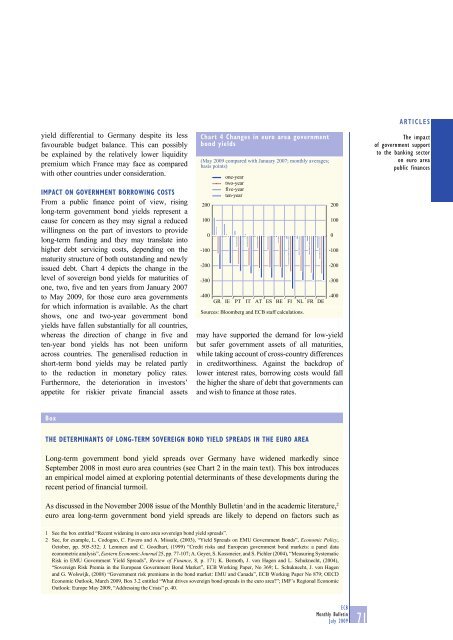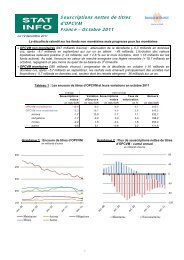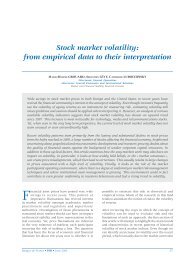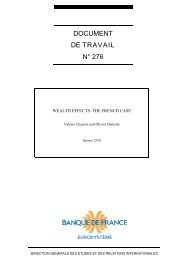Monthly Bulletin July 2009 - Banque de France
Monthly Bulletin July 2009 - Banque de France
Monthly Bulletin July 2009 - Banque de France
Create successful ePaper yourself
Turn your PDF publications into a flip-book with our unique Google optimized e-Paper software.
yield differential to Germany <strong>de</strong>spite its less<br />
favourable budget balance. This can possibly<br />
be explained by the relatively lower liquidity<br />
premium which <strong>France</strong> may face as compared<br />
with other countries un<strong>de</strong>r consi<strong>de</strong>ration.<br />
IMPACT ON GOVERNMENT BORROWING COSTS<br />
From a public finance point of view, rising<br />
long-term government bond yields represent a<br />
cause for concern as they may signal a reduced<br />
willingness on the part of investors to provi<strong>de</strong><br />
long-term funding and they may translate into<br />
higher <strong>de</strong>bt servicing costs, <strong>de</strong>pending on the<br />
maturity structure of both outstanding and newly<br />
issued <strong>de</strong>bt. Chart 4 <strong>de</strong>picts the change in the<br />
level of sovereign bond yields for maturities of<br />
one, two, five and ten years from January 2007<br />
to May <strong>2009</strong>, for those euro area governments<br />
for which information is available. As the chart<br />
shows, one and two-year government bond<br />
yields have fallen substantially for all countries,<br />
whereas the direction of change in five and<br />
ten-year bond yields has not been uniform<br />
across countries. The generalised reduction in<br />
short-term bond yields may be related partly<br />
to the reduction in monetary policy rates.<br />
Furthermore, the <strong>de</strong>terioration in investors’<br />
appetite for riskier private financial assets<br />
Chart 4 Changes in euro area government<br />
bond yields<br />
(May <strong>2009</strong> compared with January 2007; monthly averages;<br />
basis points)<br />
200<br />
100<br />
0<br />
-100<br />
-200<br />
-300<br />
-400<br />
GR<br />
one-year<br />
two-year<br />
five-year<br />
ten-year<br />
IE<br />
PT<br />
IT<br />
AT<br />
ES<br />
200<br />
100<br />
-100<br />
-200<br />
-300<br />
-400<br />
may have supported the <strong>de</strong>mand for low-yield<br />
but safer government assets of all maturities,<br />
while taking account of cross-country differences<br />
in creditworthiness. Against the backdrop of<br />
lower interest rates, borrowing costs would fall<br />
the higher the share of <strong>de</strong>bt that governments can<br />
and wish to finance at those rates.<br />
BE<br />
FI<br />
NL<br />
Sources: Bloomberg and ECB staff calculations.<br />
FR<br />
DE<br />
0<br />
ARTICLES<br />
The impact<br />
of government support<br />
to the banking sector<br />
on euro area<br />
public finances<br />
Box<br />
THE DETERMINANTS OF LONG-TERM SOVEREIGN BOND YIELD SPREADS IN THE EURO AREA<br />
Long-term government bond yield spreads over Germany have wi<strong>de</strong>ned markedly since<br />
September 2008 in most euro area countries (see Chart 2 in the main text). This box introduces<br />
an empirical mo<strong>de</strong>l aimed at exploring potential <strong>de</strong>terminants of these <strong>de</strong>velopments during the<br />
recent period of financial turmoil.<br />
As discussed in the November 2008 issue of the <strong>Monthly</strong> <strong>Bulletin</strong> 1 and in the aca<strong>de</strong>mic literature, 2<br />
euro area long-term government bond yield spreads are likely to <strong>de</strong>pend on factors such as<br />
1 See the box entitled “Recent wi<strong>de</strong>ning in euro area sovereign bond yield spreads”.<br />
2 See, for example, L. Codogno, C. Favero and A. Missale, (2003), “Yield Spreads on EMU Government Bonds”, Economic Policy,<br />
October, pp. 505-532; J. Lemmen and C. Goodhart, (1999) “Credit risks and European government bond markets: a panel data<br />
econometric analysis”, Eastern Economic Journal 25, pp. 77-107; A. Geyer, S. Kossmeier, and S. Pichler (2004), “Measuring Systematic<br />
Risk in EMU Government Yield Spreads”, Review of Finance, 8, p. 171; K. Bernoth, J. von Hagen and L. Schuknecht, (2004),<br />
“Sovereign Risk Premia in the European Government Bond Market”, ECB Working Paper, No 369; L. Schuknecht, J. von Hagen<br />
and G. Wolswijk, (2008) “Government risk premiums in the bond market: EMU and Canada”, ECB Working Paper No 879; OECD<br />
Economic Outlook, March <strong>2009</strong>, Box 3.2 entitled “What drives sovereign bond spreads in the euro area?”; IMF’s Regional Economic<br />
Outlook: Europe May <strong>2009</strong>, “Addressing the Crisis” p. 40.<br />
ECB<br />
<strong>Monthly</strong> <strong>Bulletin</strong><br />
<strong>July</strong> <strong>2009</strong><br />
71

















